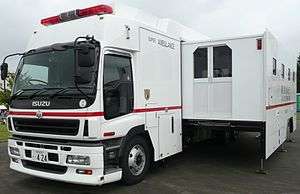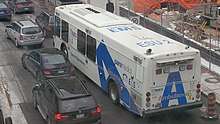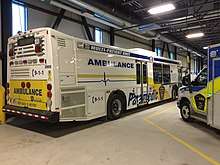Ambulance bus
An ambulance bus is a type of ambulance used to transport and treat multiple patients who require ambulance-level care. Ambulance buses have been used for a number of different purposes, including mass casualty incident response, disaster response, offering on-site triage, surge capacity, testing hospital preparedness,[1] firefighter rehabilitation, hospital evacuation, rest home (nursing home) evacuation, taking patients on routine journeys (such as holidays) for care-dependent patients or patients who use wheelchairs,[2] or to deal with specific problems such as drunken patients in town centres.[3][4] Ambulance buses can also be used to prevent health crises by providing mobile care during marathons/events[5] or providing a respite from the heat and preventing heat exhaustion on hot days.[6]

Applications
Mass casualty incident

In the event of a major disaster or evacuation, ambulance buses can be used to transport high volumes of patients or evacuate non-ambulatory patients from hospitals and nursing homes to care centers out of harm's way. Critical care transport and Advanced Life Support systems are integrated into each vehicle to accommodate the needs of patients requiring constant intensive care.[7] Ambulance buses can be deployed to major incidents, where multiple patients are present or expected, and can be used in two main ways:
- Ambulance buses can act in a stationary capacity as a casualty clearing station, field hospital, or treatment center. The units can be dispatched in advance of large events or festivals or in response to emergency events.
- Ambulance buses can be used to transport multiple stretcher-bound or wheelchair-using patients from the scene to the next definitive point of care.[8] Again, units can be used in advance of eminent danger (like the evacuation of a hospital in the path of a hurricane) or as a response to an emergency (like when evacuating a nursing home that fills with smoke or to transport a large number of patients in a large-scale highway accident[9]).
Traditional ambulance buses are designed from the ground up to handle the increased demands of multi-patient treatment and transportation. They are built with the intention of providing a close resembleace to a mobile hospital and often include large amounts of medical equipment.
Patient holiday
Some charities operate ambulance buses in a patient transport role specifically to allow stretcher bound patients to take excursions or holidays away from hospital, whilst still be able to benefit from a full care service from their healthcare escorts.[2]
Quarantine and isolation
Some mass casualty buses are specially adapted to for CBRN incidents and can be used for quarantine or isolation of contaminated patients. These vehicles may have additional features such as a sealed bulkhead to separate the driver compartment from the patient compartment. The equivalent functionality of the ambulance buses may also be built into other vehicles such as trucks, trains or other large mass transit vehicles. These mass evacuation buses are well suited for quarantine and containment.
Permanency of kit

In some cases, existing responder vehicles like used school or city buses can be used as mass casualty transport vehicles with the installation an AmbuBus Kit, which is installed inside a vehicle of opportunity to create an ambulance bus capable of transporting up to 18 nonambulatory patients.[10] These conversion kits are inexpensive alternatives when agencies do not have enough funding for a new ALS/BLS medical ambulance bus, which can often cost up to $750,000. Conversion Kits give first responders and municipalities the option of a low cost, temporarily or permanently installed conversion kits for mass casualty response. In the UK, in the post-war era of the 20th century, the Royal Air Force (RAF) had a fleet of staff buses built by Whadham Stringer. These were fitted with seats that could, when required, be taken out and the resultant platform could carry 6 standard (at the time) stretchers.
On-demand ambulance bus kits are temporarily installed inside any available vehicle (like a school or city bus) on an as-needed basis when the need is anticipated in advance, like in the case of hurricanes or planned hospital maintenance. When not in use, kits can be stored in warehouses with low maintenance costs. When needed, kits are installed and used. After use, the vehicle can be returned to daily use. With some kits, holes are drilled in the shell of the bus, requiring recertification, however other kits allow vehicles to be easily returned to daily use without recertification.[11] Temporary ambulance bus kits are ideal for hospital evacuations, mortuary affairs, and the transport of special needs patients.
No-notice ambulance bus kits are permanently installed into a vehicle of opportunity (like a school or city bus) and are on-call to respond at a moment's notice for earthquakes, terrorist attacks, or other no-notice disasters. Permanently installed kits are sometimes preferable to traditional MABs because they are less expensive than traditional ambulance buses, can be reconfigurable in the field, are transferable in case of vehicle malfunction, and can use the existing vehicle assets of a city. Permanent ambulance bus kits are ideal for mass casualty evacuation and transport, but can also be used for emergency prophylaxis distribution and firefighter rehabilitation.
| Wikimedia Commons has media related to Ambulance buses. |
References
- "High Point Regional Hospital tests its emergency preparedness". News 14 Carolina. Archived from the original on 2011-07-19. Retrieved 2010-10-28.
- "Questions and Answers". Jumbulance Travel Trust. Archived from the original on 2 July 2007. Retrieved 2007-06-02.
- "Ambulance crews prepare for party night pressure". London Ambulance Service. 2008-12-18.
- "Aboard the 'Booze Bus'". BBC News. 2007-12-17.
- "First Hospital-Based Mass Evacuation Bus in Hampton | First Line Tech". www.firstlinetech.com. Archived from the original on 2016-01-23. Retrieved 2015-08-05.
- "X Games Austin: Several treated downtown for heat, EMS says". Retrieved 2015-08-05.
- "High Point Regional Hospital tests its emergency preparedness". News 14 Carolina. Archived from the original on 2011-07-27. Retrieved 2010-10-28.
- "Mass casualty ambulance bus". Sartin Services. Archived from the original on 2008-05-09.
- "Alaska National Guardsman participate in mass casualty drill". Retrieved 2015-08-05.
- "AmbuBus Kit | First Line Tech". www.firstlinetech.com. Retrieved 2015-08-05.
- "AmbuBus". First Line Technology. Retrieved 2 June 2015.